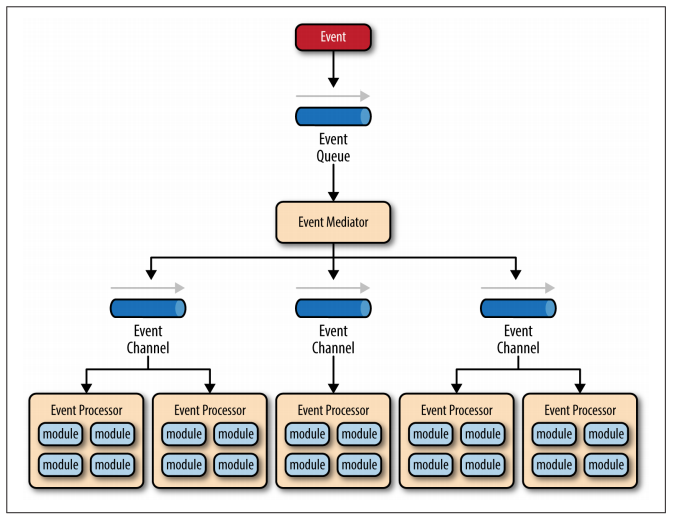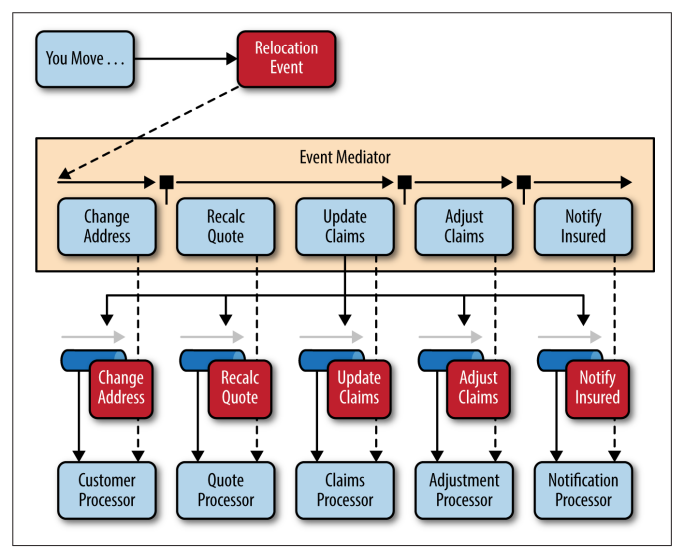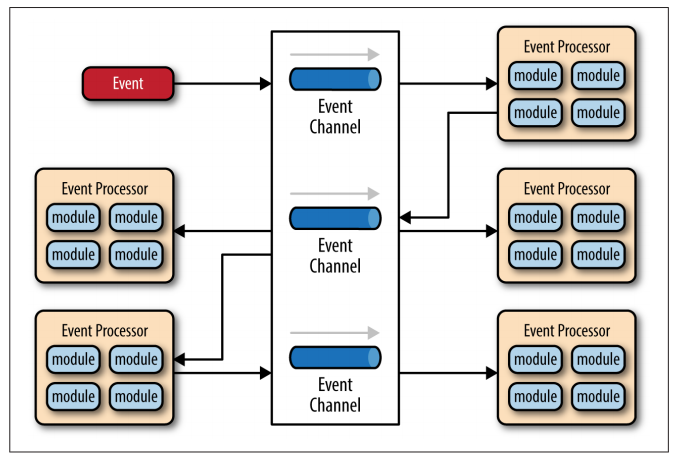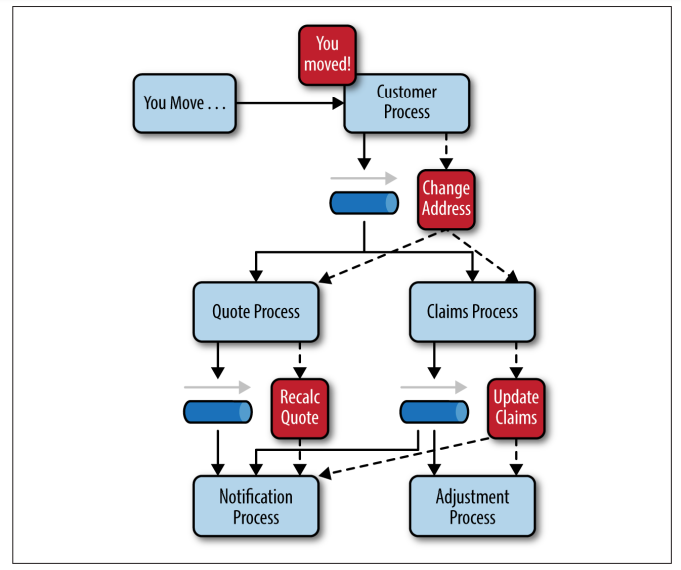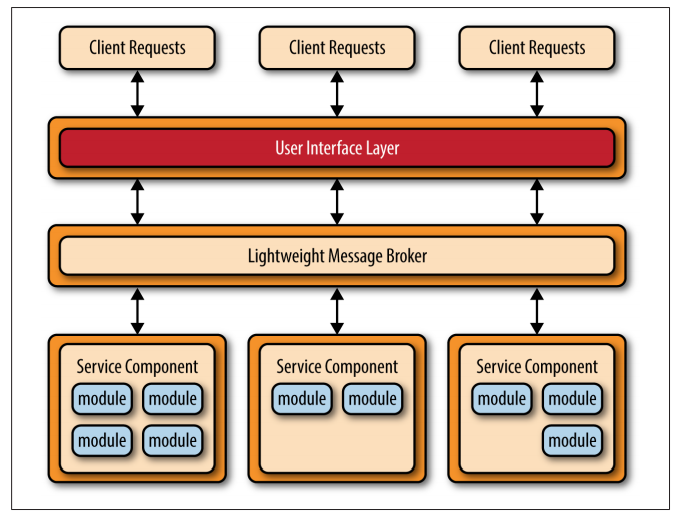...
The event-driven architecture pattern is a popular distributed asynchronous architecture pattern used to produce highly scalable applications. It is also highly adaptable and can be used for small applications and as well as large, complex ones. The event-driven architecture is made up of highly decoupled, single-purpose event processing components that asynchronously receive and process events.
...
The event-driven architecture pattern consists of two main topologies, the mediator and the broker.
- the mediator topology is commonly used when you need to orchestrate multiple steps within an event through a central mediato.
- the broker topology is used when you want to chain events together without the use of a central mediator.
Mediator Topology
The mediator topology is useful for events that have multiple steps and require some level of orchestration to process the event.
There are four main types of architecture components within the mediator topology: event queues, an event mediator, event channels, and event processors.
The event flow starts with a client sending an event to an event queue, which is used to transport the event to the event mediator. The event mediator receives the initial event and orchestrates that event by sending additional asynchronous events to event channels to execute each step of the process. Event processors, which listen on the event channels, receive the event from the event mediator and execute specific business logic to process the event.
The pattern does not specify the implementation of the event queue component; it can be a message queue, a web service endpoint, or any combination thereof
There are two types of events within this pattern: an initial event and a processing event. The initial event is the original event received by the mediator, whereas the processing events are ones that are generated by the mediator and received by the event-processing components.
The event channels can be either message queues(1 to 1) or message topics (1 to many), although message topics are most widely used with the mediator topology so that processing events can be processed by multiple event processors (each performing a different task based on the processing event received).
The simplest and most common implementation of the event mediator is through open source integration hubs such as Spring Integration, Apache Camel, or Mule ESB.
Example
To illustrate how the mediator topology works, suppose you are insured through an insurance company and you decide to move. In this case, the initial event might be called something like relocation event.
The steps involved in processing a relocation event are contained within the event mediator.
- for each initial event step, the event mediator creates a processing event (e.g., change address, recalc quote, etc.)
- sends that processing event to the event channel and waits for the processing event to be processed by the corresponding event processor (e.g., customer process, quote process, etc.).
- this process continues until all of the steps in the initial event have been processed.
- the single bar over the recalc quote and update claims steps in the event mediator indicates that these steps can be run at the same time.
Broker Topology
The broker topology differs from the mediator topology in that there is no central event mediator; rather, the message flow is distributed across the event processor components in a chain-like fashion through a lightweight message broker (e.g., ActiveMQ, HornetQ, etc.). This topology is useful when you have a relatively simple event processing flow and you do not want (or need) central event orchestration.
The broker topology is all about the chaining of events to perform a business function.
Example
To illustrate how the broker topology works, we’ll use the same example as in the mediator topology (an insured person moves).
Since there is no central event mediator to receive the initial event in the broker topology:
- the customer-process component receives the event directly, changes the customer address, and sends out an event saying it changed a customer’s address (e.g., change address event).
- In this example, there are two event processors that are interested in the change address event: the quote process and the claims process.
- The quote processor component recalculates the new autoinsurance rates based on the address change and publishes an event to the rest of the system indicating what it did (e.g., recalc quote event).
- The claims processing component, on the other hand, receives the same change address event, but in this case, it updates an outstanding insurance claim and publishes an event to the system as an update claim event.
- These new events are then picked up by other event processor components, and the event chain continues through the system until there are no more events are published for that particular initiating event.
The broker topology is all about the chaining of events to perform a business function.
Considerations
The event-driven architecture pattern is a relatively complex pattern to implement, primarily due to its asynchronous distributed nature. When implementing this pattern, you must address various distributed architecture issues, such as remote process availability, lack of responsiveness, and broker reconnection logic in the event of a broker or mediator failure.
One consideration to take into account when choosing this architecture pattern is the lack of atomic transactions for a single business process. Because event processor components are highly decoupled and distributed, it is very difficult to maintain a transactional unit of work across them. For this reason, when designing your application using this pattern, you must continuously think about which events can and can’t run independently and plan the granularity of your event processors accordingly. If you find that you need to split a single unit of work across event processors—that is, if you are using separate processors for something that should be an undivided transaction—this is probably not the right pattern for your application.
Perhaps one of the most difficult aspects of the event-driven architecture pattern is the creation, maintenance, and governance of the event-processor component contracts. Each event usually has a specific contract associated with it (e.g., the data values and data format being passed to the event processor). It is vitally important when using this pattern to settle on a standard data format (e.g., XML, JSON, Java Object, etc.) and establish a contract versioning policy right from the start.
Testability Rating: Low Analysis: While individual unit testing is not overly difficult, it does require some sort of specialized testing client or testing tool to generate events. Testing is also complicated by the asynchronous nature of this pattern.
Ease of development Rating: Low Analysis: Development can be somewhat complicated due to the asynchronous nature of the pattern as well as contract cre‐ ation and the need for more advanced error handling condi‐ tions within the code for unresponsive event processors and failed brokers.
Microkernel/Plug-In Architecture
The microkernel architecture pattern (sometimes referred to as the plug-in architecture pattern) is a natural pattern for implementing product-based applications. A product-based application is one that is packaged and made available for download in versions as a typical third-party product
...
Example: Perhaps the best example of the microkernel architecture is the Eclipse IDE. Downloading the basic Eclipse product provides you little more than a fancy editor. However, once you start adding plug-ins, it becomes a highly customizable and useful product.
Considerations
Scalability Rating: Low Analysis: Because most microkernel architecture implementations are product based and are generally smaller in size, they are implemented as single units and hence not highly scalable. Depending on how you implement the plug-in modules, you can sometimes provide scalability at the plug-in feature level, but overall this pattern is not known for producing highly scala‐ ble applications.
...
Another common approach within the microservices architecture pattern is the centralized messaging topology. This topology is similar to the previous application REST based topology except that instead of using REST for remote access, this topology uses a lightweight centralized message broker (e.g., ActiveMQ, HornetQ, etc.). It is vitally important when looking at this topology not to confuse it with the service-oriented architecture pattern or consider it “SOA-Lite." The lightweight message broker found in this topology does not perform any orchestration, transformation, or complex routing; rather, it is just a lightweight transport to access remote service components.
Considerations
Performance Rating: Low Analysis: While you can create applications implemented from this pattern that perform very well, overall this pattern does not naturally lend itself to high-performance applications due to the distributed nature of the microservices architecture pattern.
...
It is a critical component to achieving variable scalability needs within an application.
Considerations
The space-based architecture pattern is a complex and expensive pattern to implement.
...
